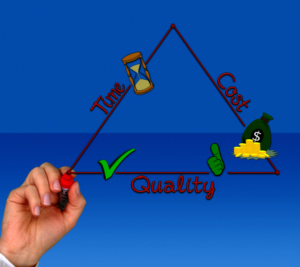
Normally at the start of a mining study, the team members receive a matrix of responsibilities. This table shows which people (or groups) are responsible for different aspects of the study, i.e. who is responsible for geology, for mine design, for process design, infrastructure, etc. This is great tool and a necessity in making sure that everyone knows what they are supposed to do.
Next we generate a project schedule based on some work plan. In realty this isn’t the correct sequence.
Sometimes the WBS is forgotten
What often gets forgotten in early stage studies is providing the team members a Work Breakdown Structure (“WBS”). I consider the WBS an equally important component as the responsibility matrix and both should always be provided.
The WBS is a hierarchical breakdown of the project into phases, deliverables, and work packages usually associated with cost estimation. It is a tree based structure, developed by starting with the final objective and then dividing that into manageable components based on size, duration, and responsibility. Typically this is done for the capital cost estimate, breaking it down into individual cost areas and cost components. A WBS can also be used for the operating cost estimate.
 The WBS can provide the following information to the team:
The WBS can provide the following information to the team:
-
It assigns the costing responsibility to specific people or group so each know what must be delivered.
-
It provides a consistent format for developing and reporting the capital costs (and operating costs).
-
It helps ensure that no cost components get omitted and no costs get double counted.
-
It provides the cashflow modeler with a clean format to import the capital cost into the cashflow model.
-
The WBS should be developed before the project schedule, not after it.
Any study will benefit from a WBS
 Typically a WBS is developed for pre-feasibility and feasibility mining studies but is often ignored at the PEA stage. Some feel it is too detailed for that level of study. I don’t feel this is the case.
Typically a WBS is developed for pre-feasibility and feasibility mining studies but is often ignored at the PEA stage. Some feel it is too detailed for that level of study. I don’t feel this is the case.
The WBS is a communication tool to confirm responsibilities. Thus even a simplified WBS is still useful at the PEA stage.
I have seen some instances where a WBS has been created but does not get wide distribution to the entire team. The WBS should be provided to everyone and ideally a team session be held to walk through the WBS structure.
The idea is not make everyone a costing expert, but rather to ensure all understand how the project cost estimate will be structured.
Conclusion
 The bottom line is that regardless of the level of study, a WBS should always be created.
The bottom line is that regardless of the level of study, a WBS should always be created.
Some will say the WBS is not required for early stage studies but I have found benefits in having one, at least for the capital cost estimate. Obviously the level of detail in the WBS should be appropriate to the level of the study.
Once the WBS is in place, then go ahead and build your project schedule.
A competent Study Manager can easily create an initial WBS, thereby mitigating some headaches when the final study is being assembled. You may even want a basis WBs at the proposal stage.
By the way, before awarding a study to anyone, try to have a prepared Request for Proposal beforehand. I have written about the benefit of this document in a blog post titled “Request For Proposal (“RFP”) – Always Prepare One“
My entire blog post library can be found at this LINK with topics ranging from geotechnical, financial modelling, and junior mining investing.

